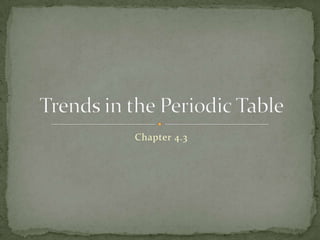Applied Chapter 4.3 :Trends in the Periodic Table
•Download as PPTX, PDF•
1 like•1,078 views
Report
Share
Report
Share

More Related Content
Viewers also liked
Viewers also liked (9)
Chapter 5.3 : Electron Configuration and the Periodic Table

Chapter 5.3 : Electron Configuration and the Periodic Table
More from Chris Foltz
More from Chris Foltz (20)
Applied Chapter 4.3 :Trends in the Periodic Table
- 1. Chapter 4.3 Trends in the Periodic Table
- 2. Objective 1: Describe periodic trends in ionization energy, atomic radius, electronegativity, and ionic size; and relate and relate them to atomic structures of the elements. Trend : predictable change in a particular direction Trends in reactivitydown a group of Alkali Metals
- 7. Formed by gain of one or more electronsIonic Radii
- 8. Valence Electrons Defined as the electrons available to be lost, gained, or shared in the formation of chemical compounds Valence electron Sodium atom Chlorine atom
- 10. Tend to increase across a period
- 11. Group trends
- 12. Tend to decrease down a group